Exploring Budapest
The beginning or ending point for most Danube river cruises, Budapest is beautiful no matter what time of year you choose to visit. Those on river cruises departing Budapest, March through December will find the Hungarian capital easy to get around and exciting to visit.
In September of 2016, I fell in love with Budapest, so much so that I posted this on Facebook:
Is this Europe’s most intriguing big city? Leading question – as I would answer yes. Of course, Paris is a contender, as is Madrid, Lisbon, Brussels, Rome, Venice, Stockholm, Istanbul and many other cities. But at the moment, Budapest has my heart.
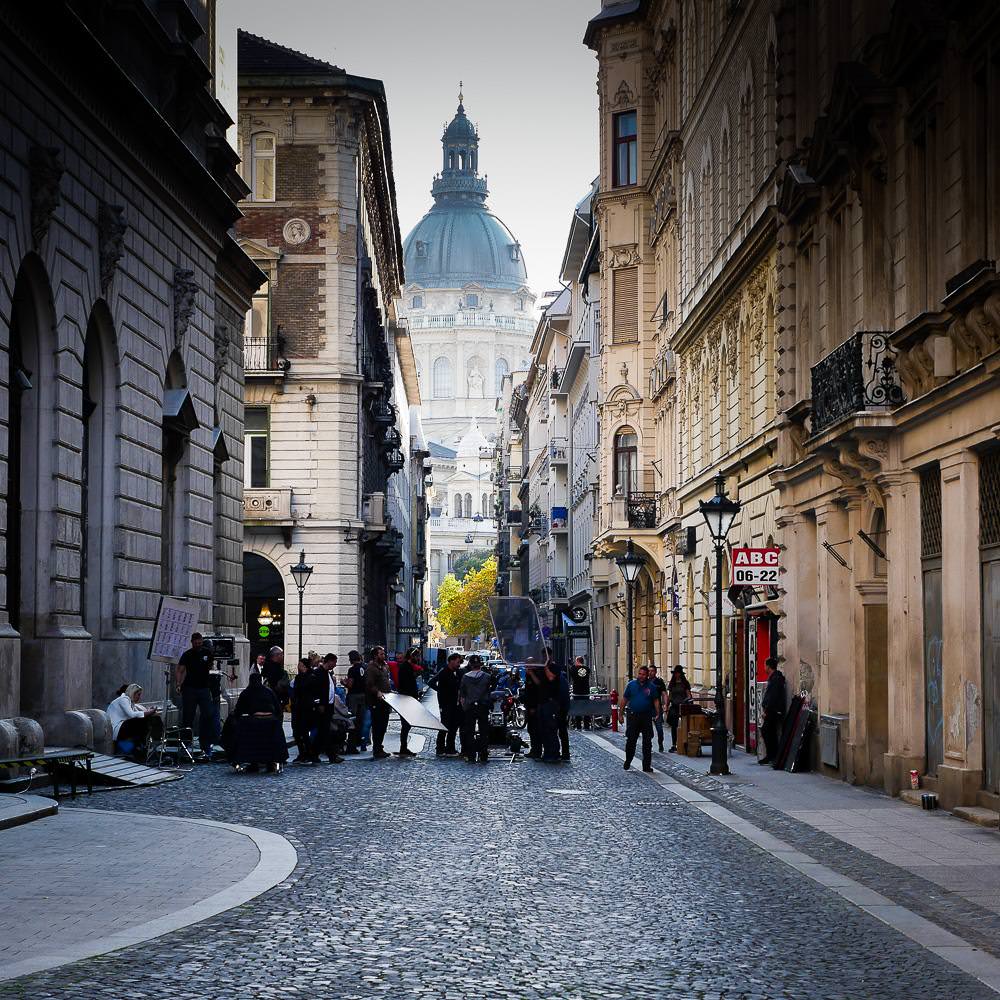
Streets near the Opera House (and the AirBnB where I stayed) in Budapest. © 2016 Ralph Grizzle
What was it about Hungary’s capital city that intrigued me so – and will likely win your heart? For starters, during the last days of September of that year, the weather was stunningly beautiful. That can make any destination shine, literally and figuratively. It seemed as though I were in Budapest at the perfect time of year. A month or two earlier would have been too soon, as summers can be oppressively hot there. In August of 2017, temperatures in Budapest soared above 100° F for a few days running. The weather during my visit was “jacket weather,” meaning that I only needed to wear a light jacket as I explored the city. More important than the weather, though, was that I had time to explore. I wasn’t just doing a shore excursion for a morning or an afternoon before sailing away. I had a few days to spend on my own getting to know this wonderful city.

AmaSonata brought me to Budapest on a 14-night cruise from Amsterdam. © 2016 Avid Travel Media Inc
My first order of business was to determine where I would pitch camp. I had enough award points to stay at the Ritz-Carlton Budapest. That would have been lavish and enjoyable, no doubt, but after two weeks of river cruising, I didn’t need more lavishness. Plus, I wanted to immerse myself in the local culture, and that meant getting away from the tourist-filled hotels. Searching AirBnB, I found a charming two-room apartment in the Terézváros neighborhood. And the cost? Only $50 a night. A steal when compared to the pricier luxury hotels.
The apartment was perfectly situated, just around the corner from the Hungarian State Opera House. From my doorstep, I would set out on adventures each day and return home to a neighborhood where the locals lived. I had found the perfect basecamp for my stay.
An Afternoon Walk Up Gellért Hill
After dropping my bags at my apartment, I did what I often do in European cities: I got to know my neighborhood – and beyond – by exploring on foot. Each day, in fact, I set off with no particular destination in mind, walking for hours. On my first afternoon, I hiked across the Danube up Gellért Hill to the Citadella. The long walk felt good on this Indian Summer day. And the views of Budapest and the Danube were stunning from my vantage point high on the hill.
The Citadella was a destination more than it was a history lesson for me. I did know from previous visits that a commander of the Austrian Empire had built the fortification in 1851. And I knew that during the Hungarian Revolution of 1956, Soviet troops occupied the fortress, assaulting the city with firepower from above. But this was more about stretching my legs and breathing in Budapest than ingesting history.
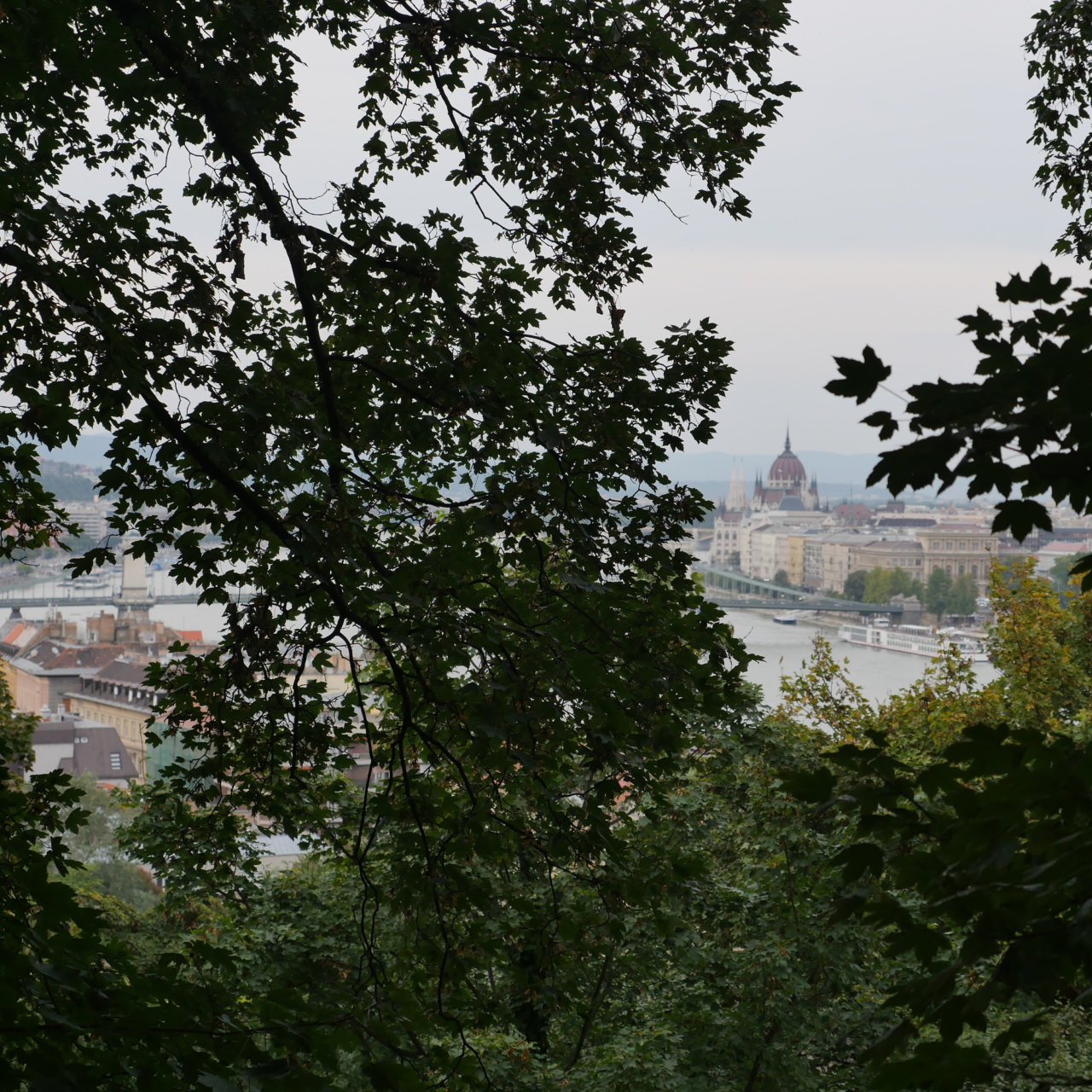
It’s a hike but the view from Gellért Hill makes it worth the effort. © 2016 Ralph Grizzle
Making my way back down from the Citadella, I stopped at the Hotel Gellért for refreshment. On my many visits to Budapest, I had never walked into this historic hotel. The lobby was grand and impressive. On the stairs near the reception desk was a series of stained glass windows featuring a design from Hungarian Mythology. Csodaszarvas, which roughly translates to the Miraculous Deer, is an intriguing story.
Miniature of the hunt of the White Stag, with Hunor and Magor in the foreground. Anonymus (P. Magister), Public domain, via Wikimedia Commons
A much-abbreviated version of the legend goes that while out hunting, the brothers Hunor and Mago (ancestors of the Huns and the Magyars) came upon a white deer. They pursued the animal but it always stayed ahead. The two brothers became lost in their hunt and eventually (after some years, in fact) found their way to a kingdom where they married two princesses and founded the nomadic nation of the Huns. Tell any Hungarian history teacher that story and they’d probably laugh at you. Still, this gives you an idea of what the glass mural at Hotel Gellért represents and it also provides some insight into the Hungarian culture.
The legend aims to provide a common ancestry for the Huns and the Magyars. Who were these two tribes? The Magyars were led by prince Árpád, who, in the 890s, conquered the area that would become Hungary. In the 5th century, the territory had been occupied by Attila the Hun. The legend shows that the Magyars were simply reclaiming their ancient homeland as descendants of Attila.
The real story is much more complex. No one knows for sure where the Huns originated. What is known is that they were seen as ruthless savages who plundered their way through much of the Western and Eastern Roman empires in the 4th and 5th centuries.
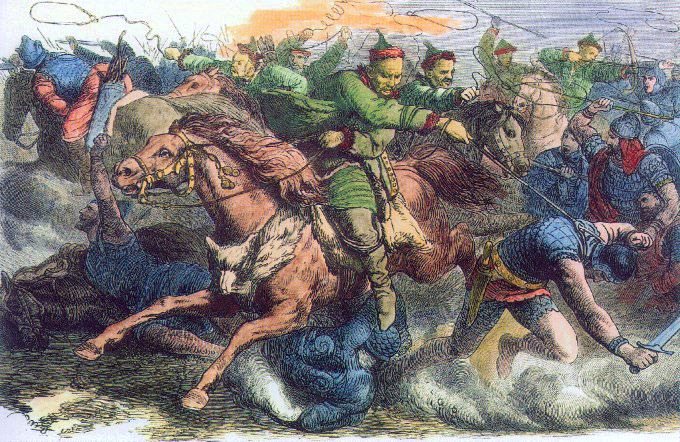
Highly skilled at horseback archery, the Huns pillaged and plundered much of the Romain Empire. Attila the Hun was ruler of the Huns from 434 until his death in 453. The formidable enemy was much feared during his campaigns against the Romans. Image credit: Peter Johann Nepomuk Geiger, Public domain, via Wikimedia Commons {{PD-US}}
Today, the name Attila is often associated with Hungary. In Budapest, you’ll find streets named Attila. You’ll meet men named Atilla. Even so, most mainstream scholarship dismisses the notion that the Hungarians rose from the Huns. Scholars say that the people who would become the Hungarians (the Magyars) came to the Carpathian Basin a few hundred years after the Huns. Their country was – and is today – Magyarorszag, meaning Magyar Country. Like the Huns, however, the Magyars were also fierce, nomadic warriors on horseback, which explains in part how Hungary got its name.
When the Magyars arrived in the Carpathian Basin, they fought Bulgarian tribes who referred to their land as On-ogur. The Magyars conquered the tribes and took over the region. The name of the Hungary today has nothing to do with the Huns but rather derives from the Latin translation of On-ogur, which is Ongarus. Still, the association with the Huns persist, as noted with street names and male names in Hunary. In 2014, news emerged that construction workers in Budapest unearthed a burial chamber thought to be the final resting place of Attila the Hun. The chamber contained “human remains, many horse skeletons, a large sword made of meteoric iron, pottery, jewellery, and other weapons and grave goods traditionally associated with the Huns, all pointing to the tomb being the resting place of a great Hunnic leader,” according to the website Ancient Origins. It turned out to be a hoax.
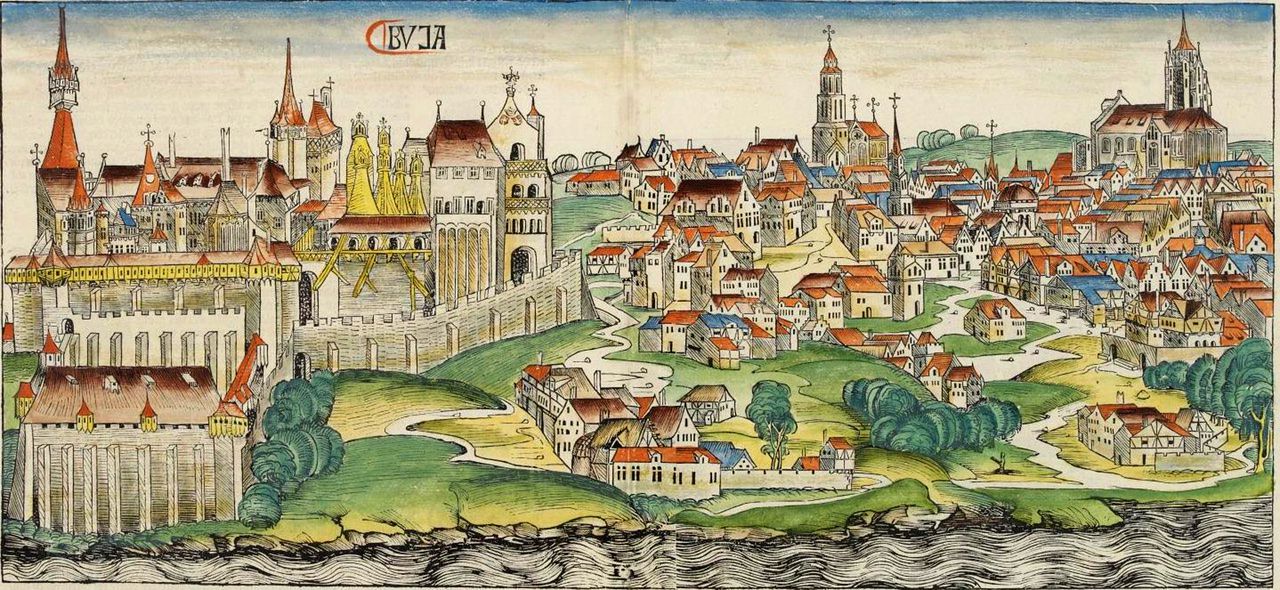
Buda during the Middle Ages, woodcut from the Nuremberg Chronicle (1493). Michel Wolgemut, Wilhelm Pleydenwurff (Text: Hartmann Schedel), Public domain, via Wikimedia Commons
Hungary’s history is complex. Originating from what is today France, Celtic tribes were among the first to settle in the area that now makes up Budapest. In the 4th and 3rd centuries BC, the Celts settled near Gellért Hill before being ran off by the Romans in 10 AD. The Romans established the military base Aquincum. A city of 30,000 inhabitants eventually grew around the fortress. Today in Budepest, you can visit the Aquincum Museum, which opened in 1894, to get a feel for the ancient city.
Various tribes controlled the region, with the Romans ceding territory to the Huns. The Mongols arrived in the 1200s to pillage the area, then came the Ottomans who ruled over Hungary for 150 years. In the late 1600s, Buda entered a new age of prosperity, and in 1783, Budapest was the name given to a global city following the unification of Buda, Óbuda, and Pest.
Budapest also became the co-capital (along with Vienna) of the Austro-Hungarian Empire, which dissolved in 1918 following World War I. Other wars and battles followed: the Hungarian Revolution of 1848, the Battle of Budapest in 1945, and the Hungarian Revolution of 1956. Through all of this the city survived and thrived.
It was at the end of the Austro-Hungarian Empire that Hotel Gellért opened. The art nouveau landmark was named for Saint Gellért, the first bishop of Hungary. Back then, as is the case now, Budapest was known for its thermal baths, and today the Gellért Spa features indoor and outdoor swimming pools, a wave bath, a sunbathing terrace and a thermal spa. With its beautiful outdoor and indoor pools studded with turquoise ceramics, the Gellért Spa is one of several thermal baths in Budapest.
With no time to relax in thermal baths, I spent the rest of the afternoon walking, absorbing the feel of Budapest. As evening approached, the golden glow of September cast itself against beautiful buildings. The city was a visual feast.
Speaking of feasting, I was famished as evening approached. Just steps away from my apartment’s front door, the small restaurant A Presto looked appealing. It was just the kind of place I enjoy most. Unpretentious, good value and freshly prepared food. The whole restaurant was no bigger than my apartment. A Presto had a cozy and welcoming feel to it. I particularly enjoyed the homemade garlic sauce on a plate of gnocchi, and I felt as though I was the only tourist in the restaurant crowded with locals.
While in Budapest, you’ll also want to try the Fogas, which is Lake Balatan pike-perch, breaded and fried or grilled. The Fisherman’s soup (halaszle), another favorite, is a rich mixture of several kinds of poached fish, tomatoes, green peppers and paprika.
A ‘Ruined’ Night
When searching online for Fogas, you might find Fogashaz. This is not a restaurant but a three-story nightclub. Fogashaz is a so-called ruin bar. These are basically bars or nightclubs which were decaying and abandoned buildings where investors saw opportunities to develop social venues. You’ll find many in the old Jewish quarter.
I spent the evening at one, sipping a beer and listening to live music. I talked with a few locals and enjoyed the atmosphere. I could not do a better job describing the atmosphere than a writer friend Nomadic Matt, who writes: When you’re in these bars, you feel like you’re drinking at your local thrift store. None of the furniture matches. It’s all old. It’s eclectic. It feels like they just ransacked your grandmother’s house … the places haven’t been repaired or fixed up, and there are still holes in the walls and visible pipes everywhere … but it all adds to the “underground” feeling each ruin bar has. If these places hadn’t been pointed out to me, I never would have found them.
I would never have found them either. It was places like the ruin bars and my neighborhood restaurant A Presto that made my stay in Budapest so special. There is a warmth about the city that makes visitors feel welcome. For a longer stay, the prices were appealing too, not just the daily rate of my apartment but also the cost of food and drink. With its official currency the Forint, Budapest offers more value than you would often get in other big cities in Europe.
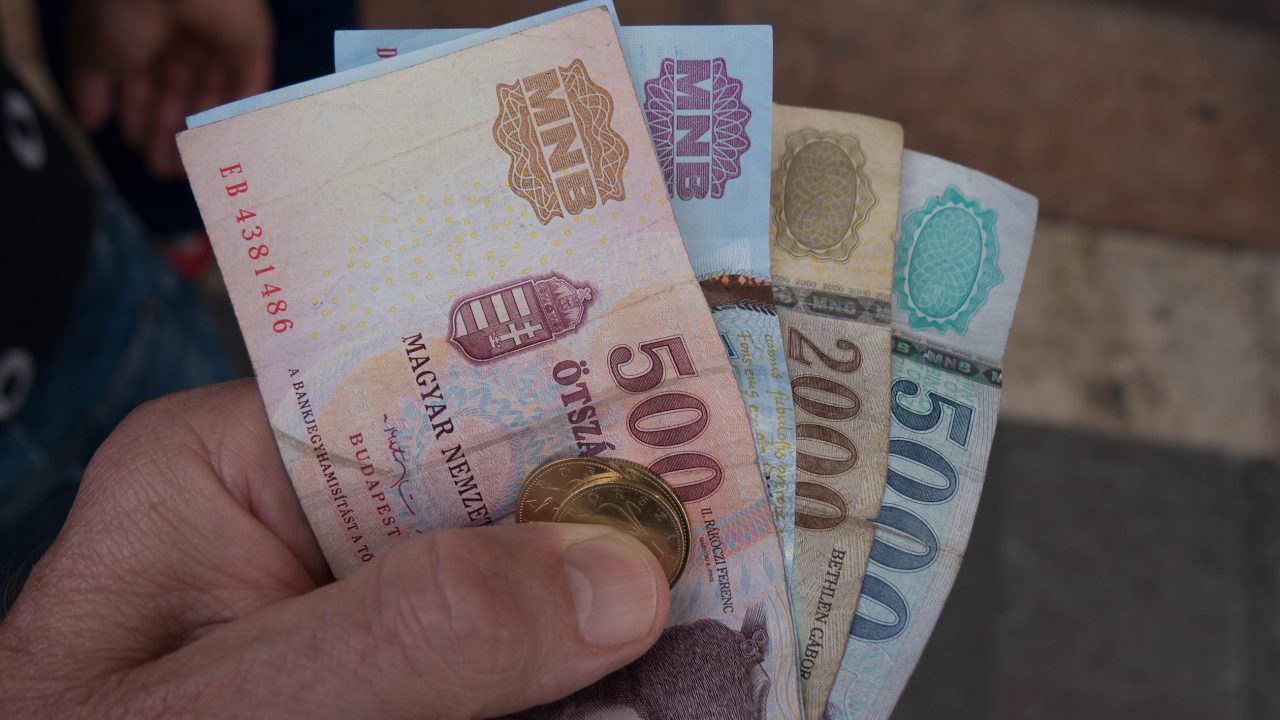
Budapest is not only beautiful but affordable. For value, it may just be the best city for travelers in all of Europe. You’ll need to change money in Budapest or use your credit card as the national currency is the Forint. © 2016 Ralph Grizzle
The Jewish Quarter & House of Terror
The next day, I strolled through the Jewish quarter. With its mix of restaurants, bakeries and bars, the Jewish quarter is a lively place today, but, of course, it has a sad history. Near the end of World War II, Jews were forcibly relocated to this area when Nazi troops occupied the city beginning on March 19, 1944. The ghetto was established several months later, in November 1944 and ended when Soviet troops liberated Budapest on January 17, 1945.
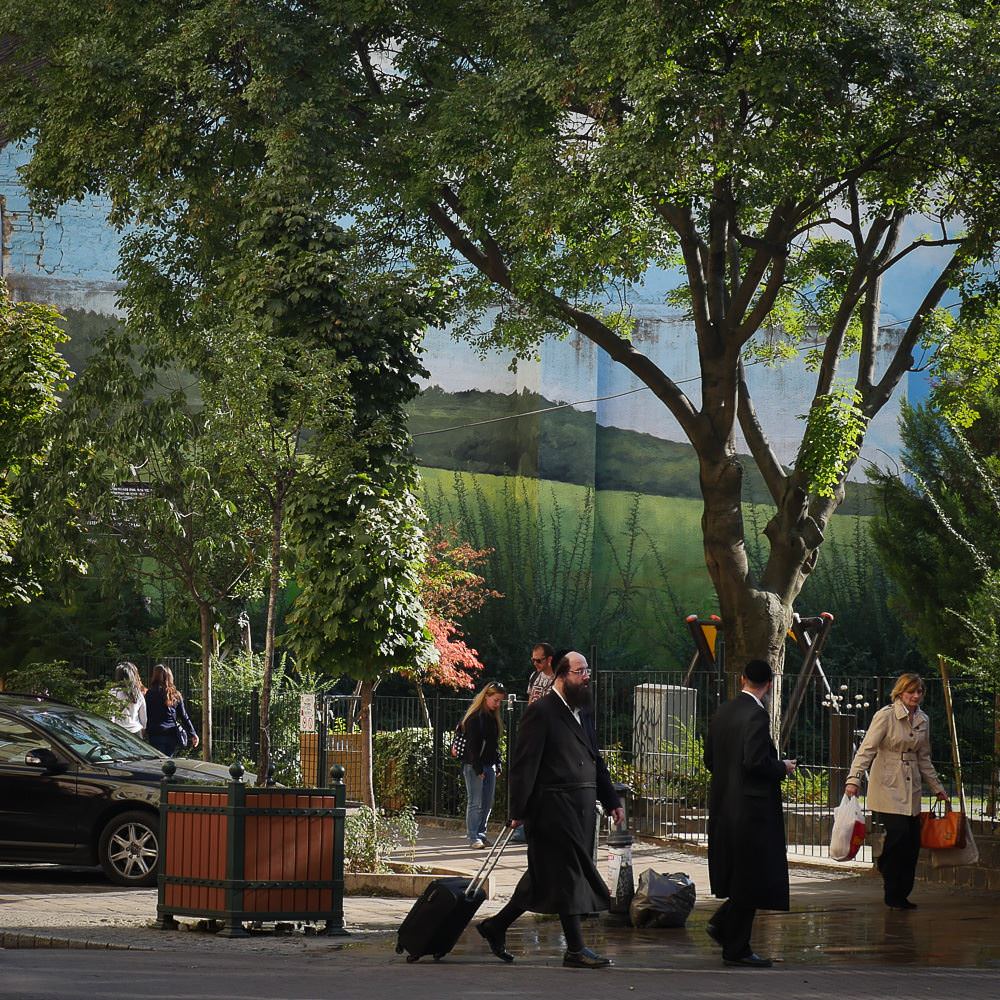
The Jewish quarter in Budapest. © 2016 Ralph Grizzle
On the edge of the Jewish Ghetto is the Dohány Street Synagogue, a beautiful Moorish building constructed in the 1850s. It’s definitely worth a step inside, and you can an immersive look on a guided tour. Outside the synagogue is a mass grave that pays tribute to the 2,000 Jews killed here during the Holocaust. It is a moving commemoration.
My next destination was a 20-minute walk, and I’d have to backtrack a bit. I headed back toward the Opera House to Oktogon Square. From there, I walked along Budapest’s most famous avenue, Andrássy, to the House of Terror, situated in the former headquarters for the secret police of both the Nazi and Communist governments. One of Europe’s most emotionally moving museums, the House of Terror depicts the horrors against Hungary during the Nazi and Communist regimes.
After spending an hour in the museum, I continued along Andrássy to Hero Square, where monuments were built in 1896 to commemorate the 1000th anniversary of the arrival of the Hungarians. I also strolled through the City Park, situated adjacent to the square.
For lunch, I was in luck. At the City Park, Gundel is perhaps the most famous restaurant in Budapest. In 2020, the restaurant closed temporarily because of the global pandemic. Gundel’s website notes: During the 125-year history of the legendary Gundel, there have been several other occasions where the restaurant has had to close — for example, in 1944 during WWII, from 1972-1980 during a long renovation, and from 1991-1992 during a complete rebuilding. After the previous closures Gundel has always returned stronger, reopening its gates ready to face new challenges.
For lunch, I opted for one of the restaurant’s signature dishes, the Gundel Palacsinta, the century-old pancake that has filled with rum, raisin, lemon rind and walnuts, served with a chocolate sauce – baked and flambéed upon request. It was delicious. While dining, I learned that New York architect Adam Tihany had assisted in Gundel’s updated design. I had interviewed Tihany several times for his role in designing Seabourn’s luxury ships.
My next destination was to see one of the most moving exhibits in Budapest. It took me nearly an hour to walk just over two miles to the Danube. There, on the riverbank, is a memorial that honors the memory of Jews who were ordered to remove their shoes before Fascist Hungarian militia aimed their rifles and shot innocent people at the river’s edge. The massacre is commemorated by bronze shoes along the river.

Nikodem Nijaki, CC BY-SA 3.0, via Wikimedia Commons
Moved by all that I had seen, I began to make my way back to my apartment. In juxtaposition to a day spent learning about Hungary’s heart-breaking history during World War II, my walk back was just the opposite. I passed through happy neighborhoods, parks where families were gathered and children playing, outdoor restaurants where people were enjoying the autumnal glow and warmth of the evening.
Up, Up & Away To Castle Hill
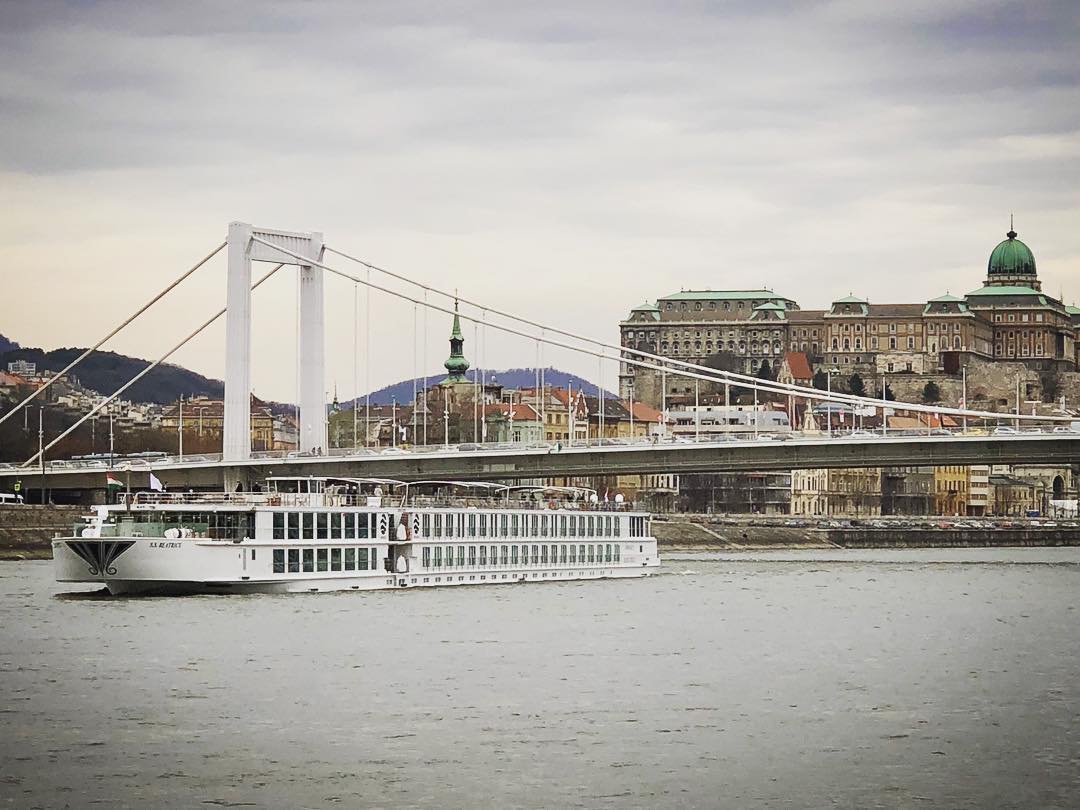
Overcast skies but Uniworld’s Beatrice shines bright against Castle Hill in the background. © 2018 Ralph Grizzle
Situated on opposite sides of the Danube, Buda and Pest were united in the 19th century to form the Hungarian capital Budapest. Hilly Buda retains much of its Middle Age charm. Its cobbled streets and Gothic buildings have been well preserved. On the other side of the river, Pest is the thriving city center.
River cruisers typically dock on the Buda side, within walking distance of Castle Hill. For those who prefer, there is a funicular that will take you up to the site. I crossed the Danube and headed uphill to enjoy beautiful views of the Danube and Pest.
I spent three or four hours exploring Castle Hill, visiting Buda Castle, the Fisherman’s Bastion and the Matthias Church as well as admiring the museums, galleries, shops and cafes. For fun, I took the funicular back down to the river. The Budapest Castle Hill Funicular (Budavári Sikló) opened in 1870. Destroyed during the Second World War, the funicular didn’t reopen until 1986. Today, it carries guests between the Chain Bridge and Buda Castle.
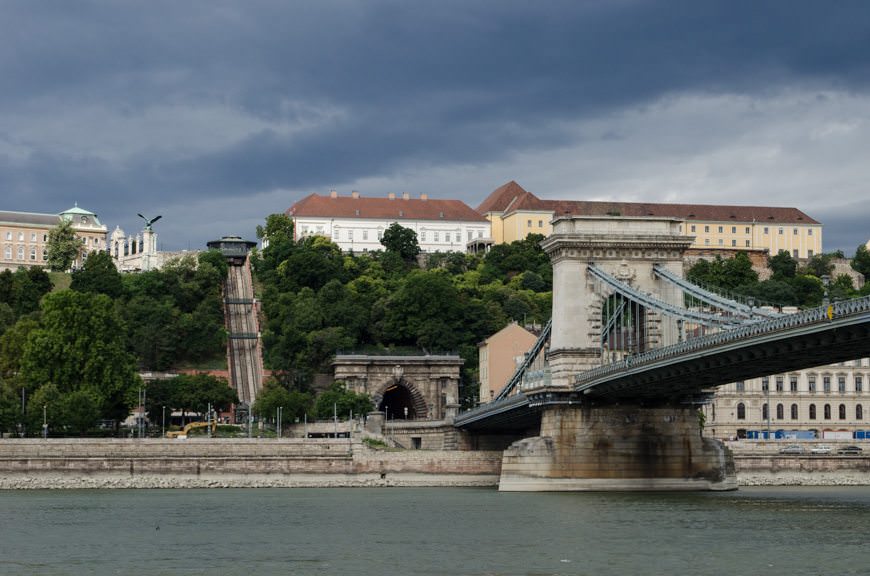
The Chain Bridge at right and the Buda Hill Funicular in the distance. Photo © 2015 Aaron Saunders
At the foot of Castle Hill, the Chain Bridge was named after István Széchenyi, who was a major supporter of the bridge during its construction in 1840. The name of the bridge was has nothing to do with chains but rather is a shortened version of Széchenyi (se-chain-ee) The bridge was completely destroyed in World War II, save for its towering buttresses. It was rebuilt and reopened in 1949.
As I walked across the Chain Bridge, I stopped to appreciate the views several times, snapping photos, before returning to the city on the other side of the Danube. Once across the bridge, I stopped at the Four Seasons Hotel to admire its grand lobby.
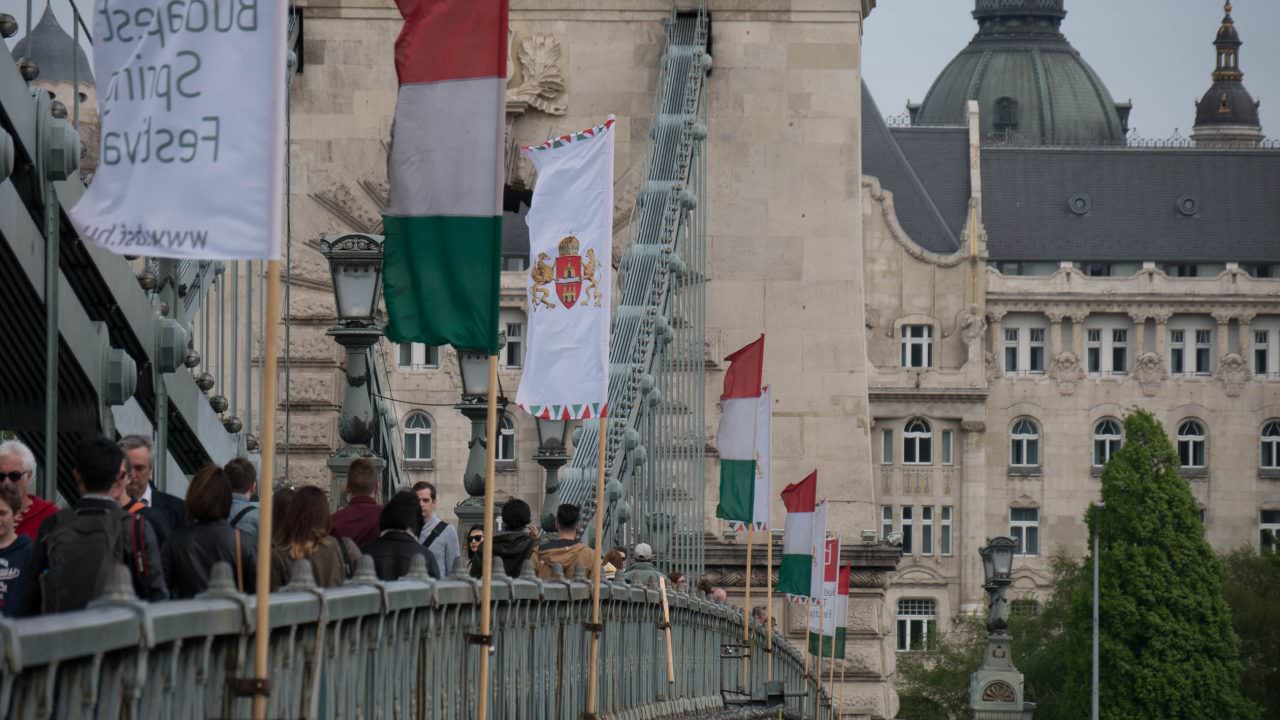
The Chain Bridge joins Buda and Pest. © 2016 Ralph Grizzle
From there, I headed to Vaci Utca, the pedestrian-only shopping street, just a few minutes walk away from the Four Seasons, stopping along the way to admire St. Stephen’s Basilica, named in honor of the first King of Hungary (c 975–1038), whose “incorruptible” right hand is housed in the reliquary.
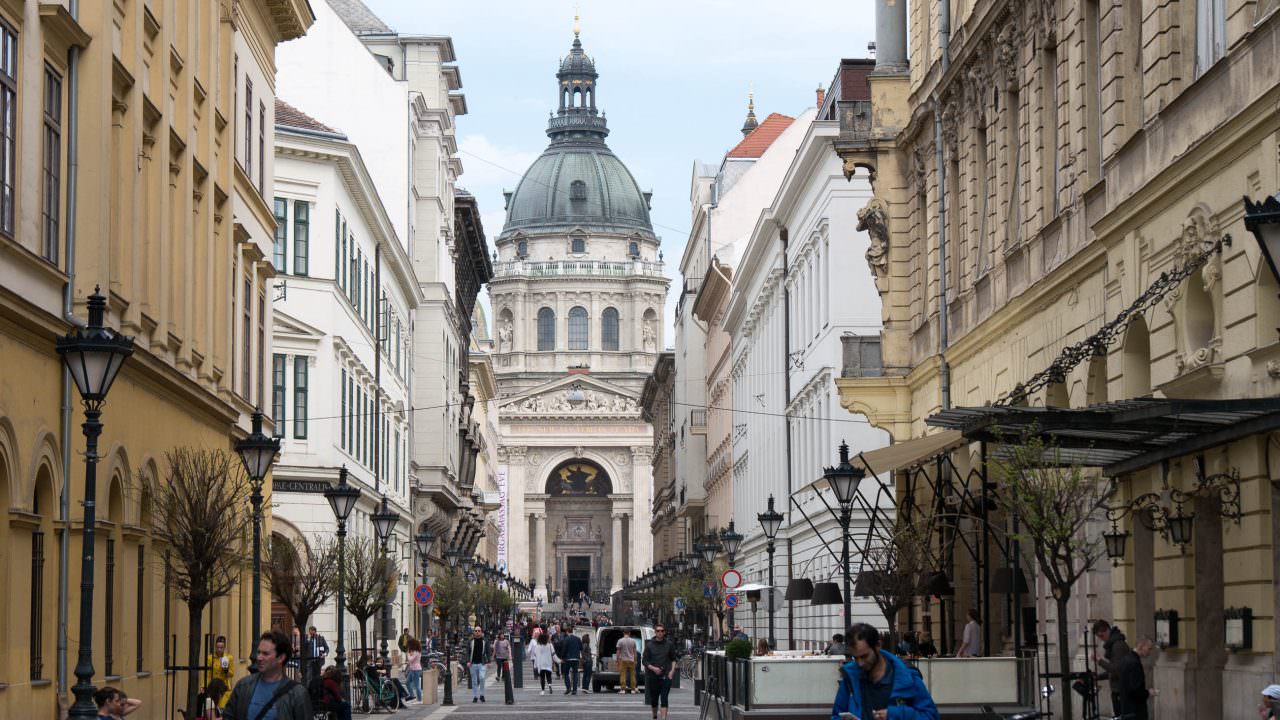
St. Stephen’s Basilica in Budapest. © 2016 Ralph Grizzle
I continued from there to Vörösmarty tér, a large and lively square, where I sat down for coffee and a slice of the moist plum pie known as zilvás lepény at Cafe Garbeaud. The well-known landmark has stood here since 1870. Because of its popularity and the fact that it has become a tourist attraction, Cafe Garbeaud has lost some of its charm. Nonetheless, it’s worth a peek inside the “filled to capacity” cafe. There are cafes that arguably are more enjoyable in Budapest, including Cafe Pierrot back at Castle Hill.
From Cafe Garbeaud, I made my way to Vaci Utca where I strolled along tram tracks. The trams have been in operation since 1866, originating as horse-tram lines.By 1885, Budapest had as many as 15 horsecar lines.
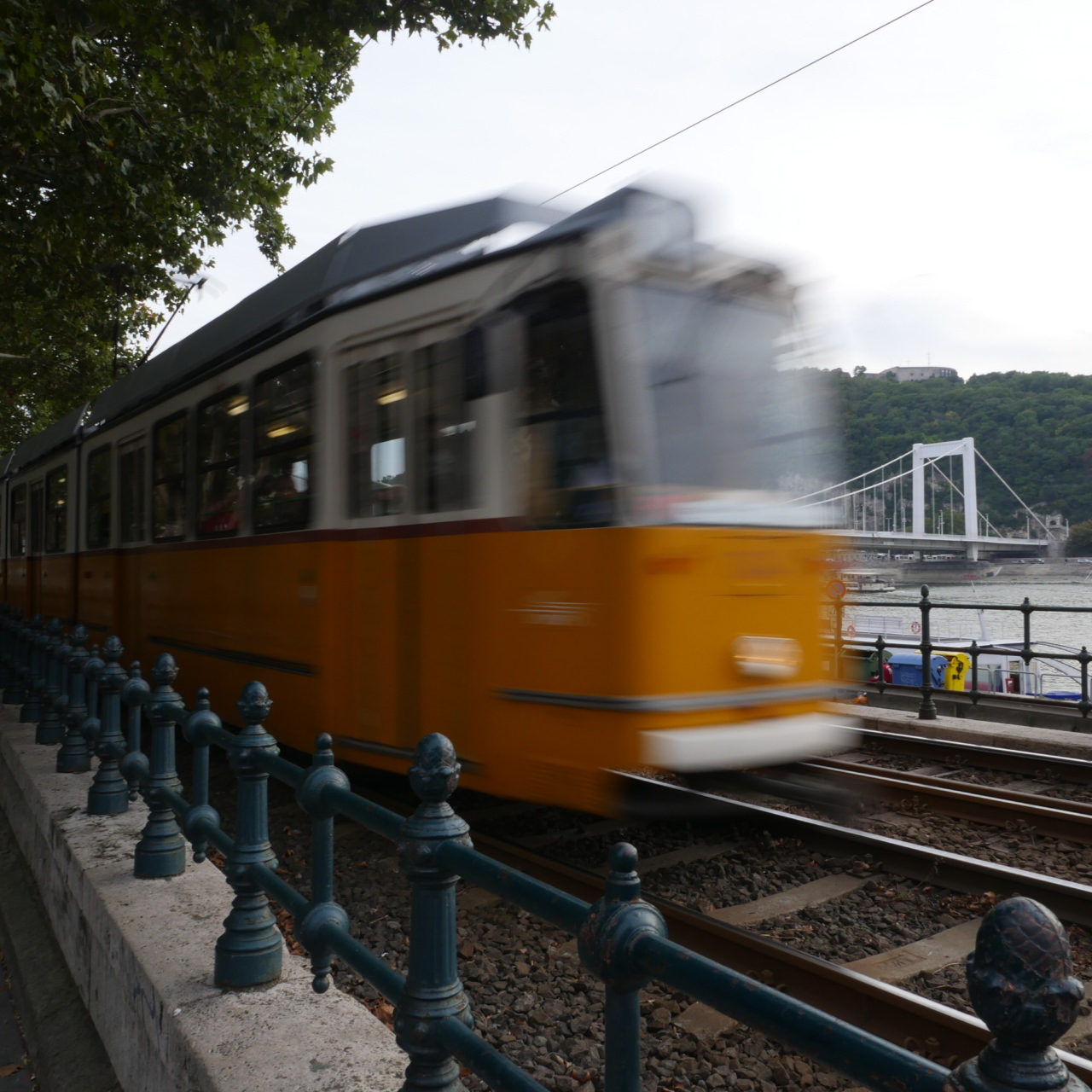
Budapest tram. © 2016 Ralph Grizzle
Budapest also boasts the oldest underground railway system in continental Europe, pre-dated only by the London Underground. The iconic M1 Line was completed in 1896 and was named a UNESCO World Heritage Site in 2002. The railway is a mix of metro and amusement ride, with its cute cars and noisy, curved tracks.
I ended my walk at Market Hall, which opened in 1897 and remains the city’s oldest and largest indoor market. I passed stalls on the ground floor offering produce, meats, pastries, candies, spices, and spirits. Many of them have items that are popular with tourists: paprika spices, Tokaji wine, Túró Rudi, kolbász sausage and salami. The second mezzanine floor has eateries and tourist souvenirs. The basement contains fish mongers, picked vegetables stalls and a few specialized butcher shops. I picked up souvenir paprika and made my way out.
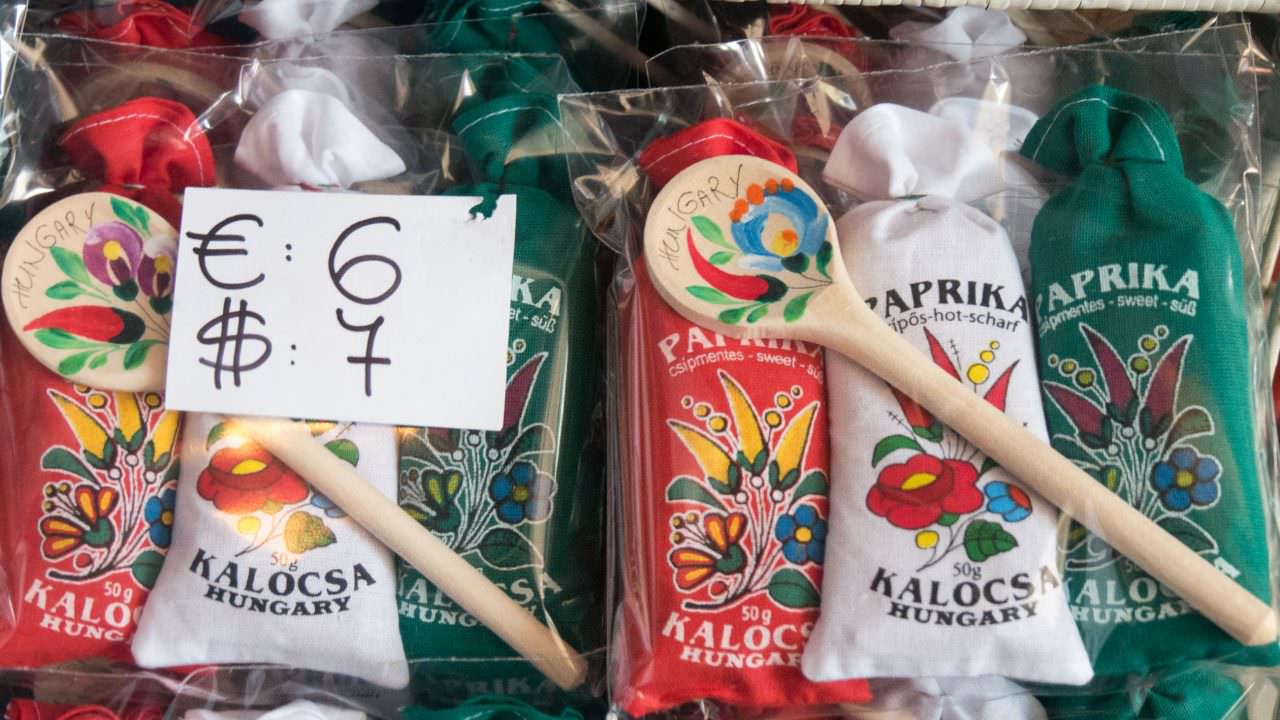
Paprika at Market Hall. © 2016 Ralph Grizzle
Aside from trams or walking, another way to get around Budapest is by bike. I toured Budapest by bike while on an AmaWaterways cruise in conjunction with Backroads, which bills itself as the world’s number one active adventure company. Despite having been to the Hungarian capital countless times, from the perspective of two wheels, I saw many parts of the city that I had not seen on previous visits. It is amazing how seeing any city by bike can show you an entirely different place than you’d see on a motorcoach or on a walking tour. One word of warning is that Budapest’s bike lanes are not as extensive as you’d find in other cities, and traffic and trams make for chaotic intersections at times. Be careful if you opt to pedal Budapest.
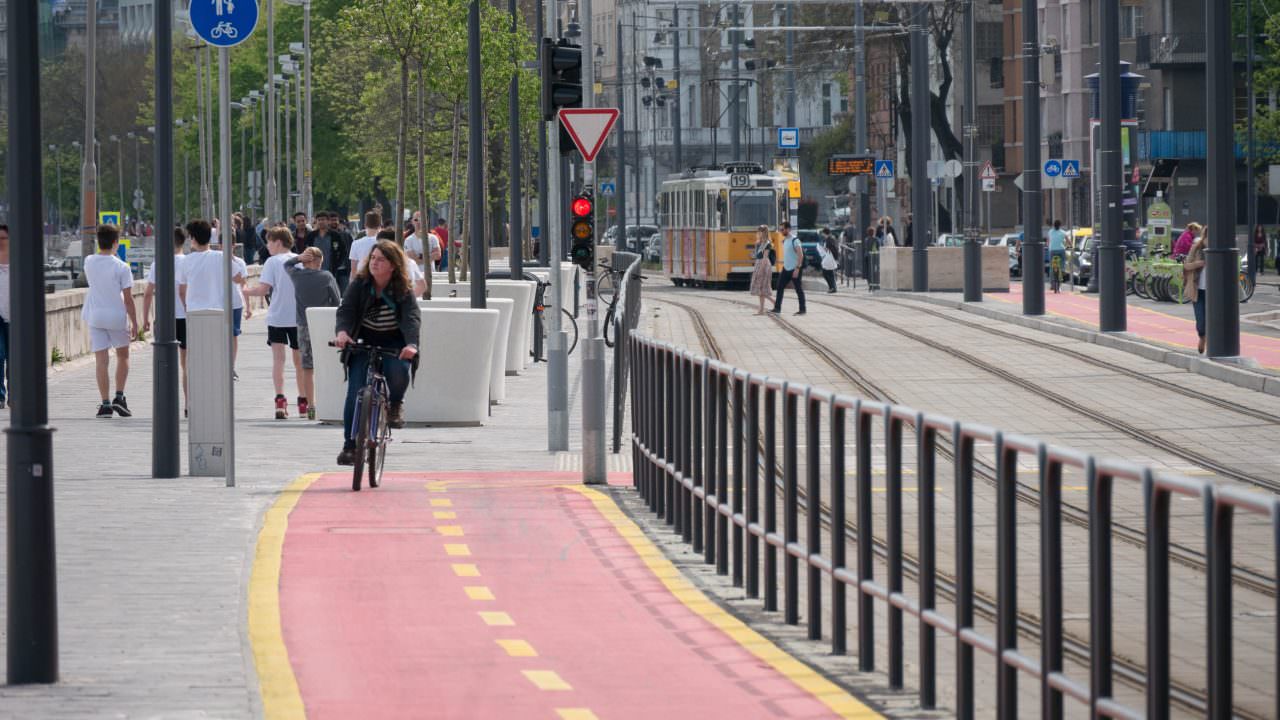
Along the river quay where ships dock in Budapest: pedestrian and bike-friendly. © 2016 Ralph Grizzle
Budapest By Night
Cruise companies offered Illumination Tours until 2019, when a Viking longship collided with a small tourist boat near the Margaret Bridge. The tourist boat sunk in seconds, killing more than two dozen South Korean tourists and Hungarian crew. Some river cruise companies halted night sailings following the incident.
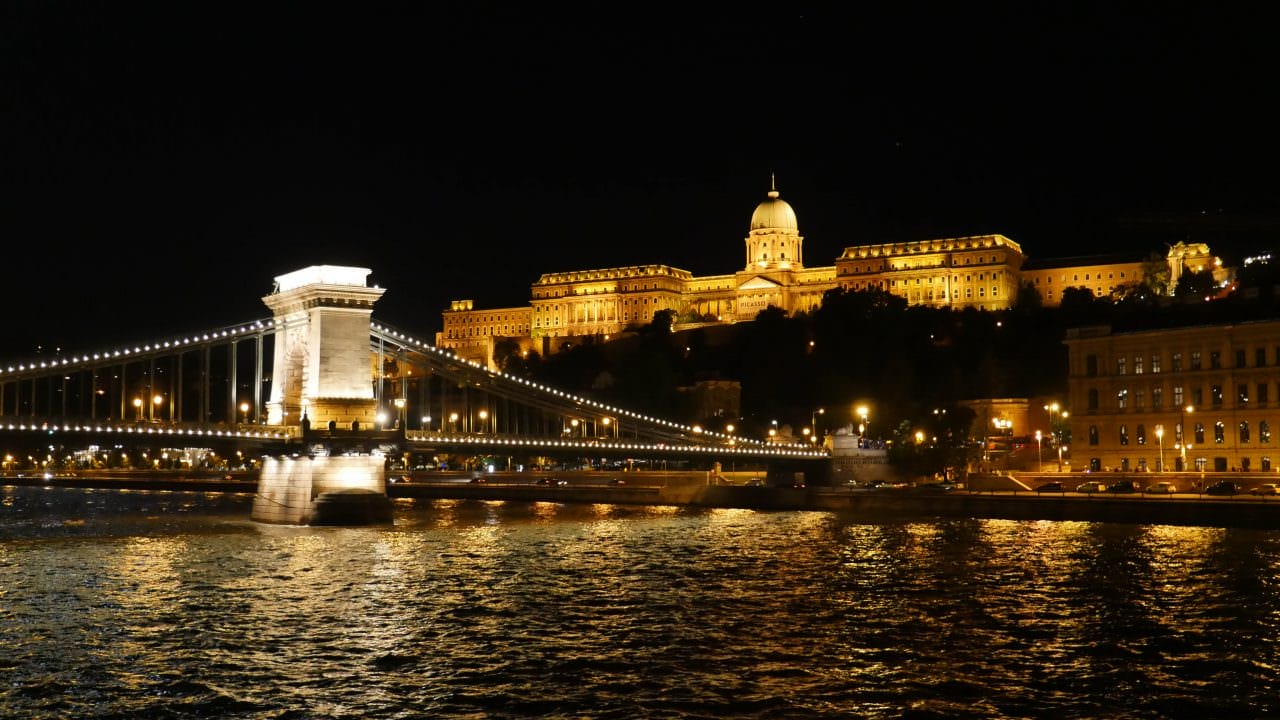
Castle Hill during an illumination tour. © 2016 Ralph Grizzle
I was fortunate to have done several illumination tours before the tragedy. All of my night cruises took place after dinner when nearly everyone aboard gathered on the top deck to admire the city all aglow. The highlight is Hungary’s beautiful Parliament building. Construction started for the new building facing the Danube in 1885, but it was not until 1896 (the 1000-year anniversary of Hungary) that the building was inaugurated. During the People’s Republic of Hungary a red star perched on the top of the dome, but it was removed in 1990 after the fall of communism.
What I saw above the dome on the evening I cruised was completely unexpected. I though stars were twinkling above the building, but then I noticed the stars were moving. They were not stars after all but migratory herons. What a way to end a cruise.
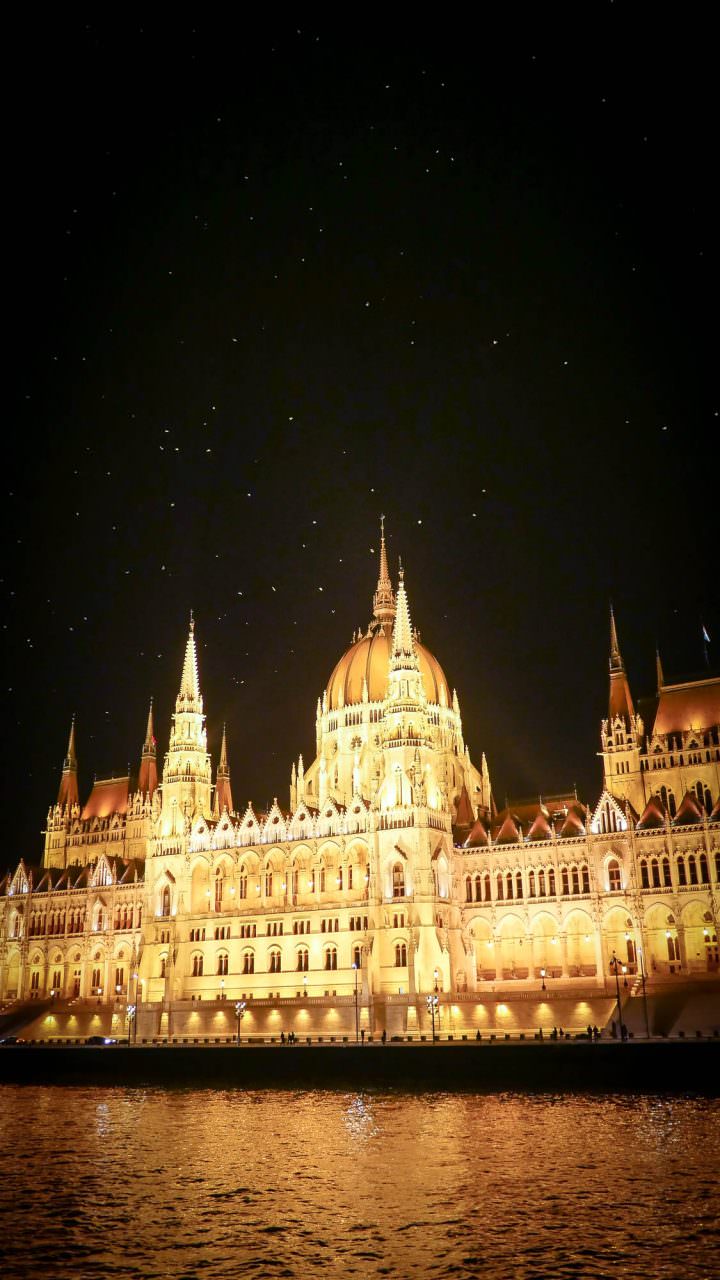
Stars above Hungary’s Parliament? Nope, they’re herons. © 2016 Ralph Grizzle
Like those unexpected herons, Budapest surprises and delights, and it had certainly done so during my short visit. I knew before leaving that I wanted to return here for a longer stay. Once referred to as the “Queen of the Danube,” the city’s beauty becomes more apparent as you realize how much of it was destroyed or damaged during the Second World War and put back together, brick-by-brick, into the style that represents both then and now. Is this Europe’s best big city? Make your own decision by exploring Budapest on your next Danube river cruise.
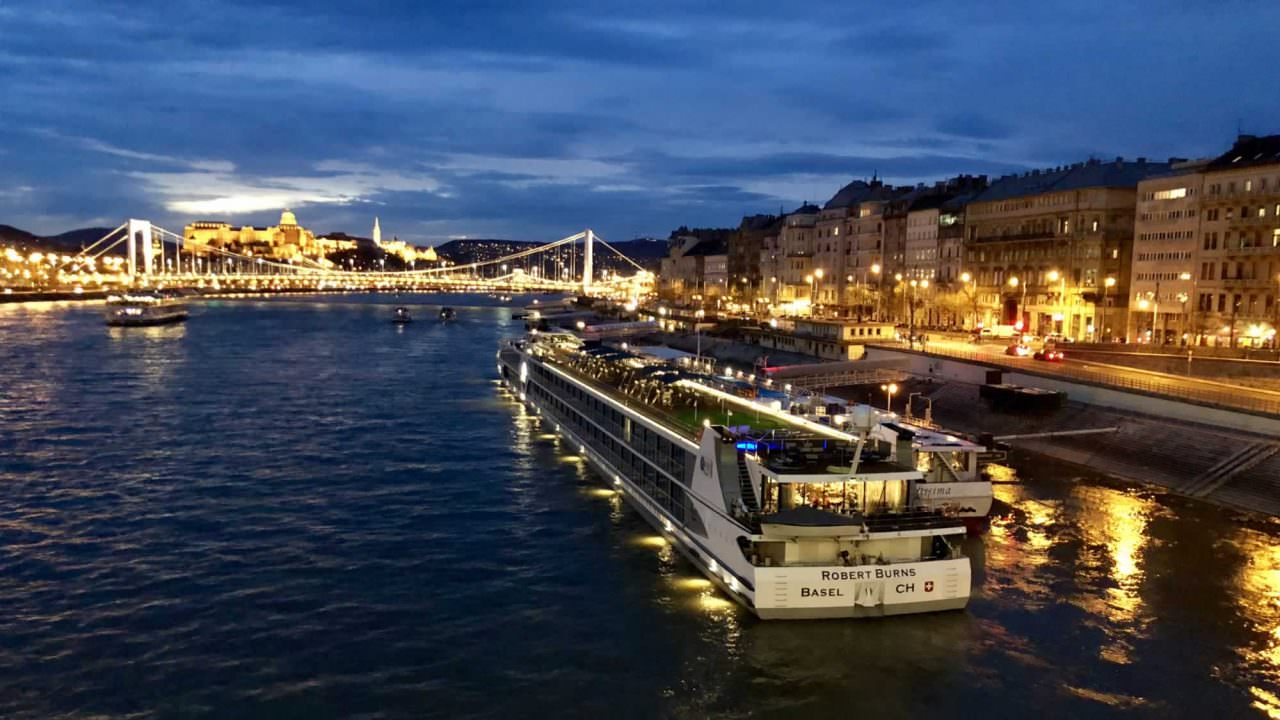
Docked in Budapest, Riviera River Cruises’ m/s Robert Burns. © 2018 Ralph Grizzle
Please share your Budapest tips or experiences in the comments below. Thank you.
Want to see a little more of Budapest? Click here to launch a Flickr slideshow.

Very well written article. Thanks for publishing!
My favorite city to start or end a Danube River cruise, especially during the Christmas Markets.
Budapest is one of my very favorite cities! Absolutely beautiful with a great and friendly atmosphere. The illumination tour while on the Beatrice was so special. Unforgettable Budapest! Thank you for your article!
Is the Euro the currency in Hungary? What about Germany? Thank you in advance.
Hungary is not using the Euro but Germany is.